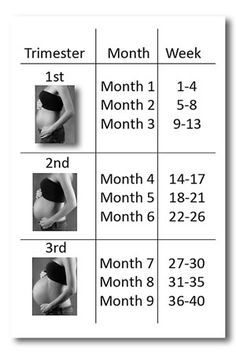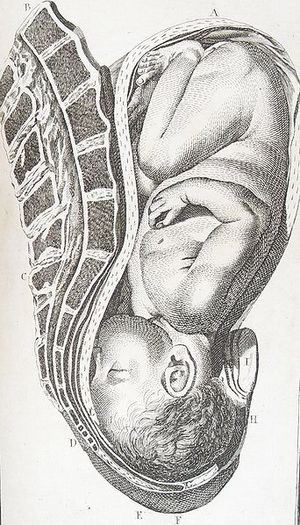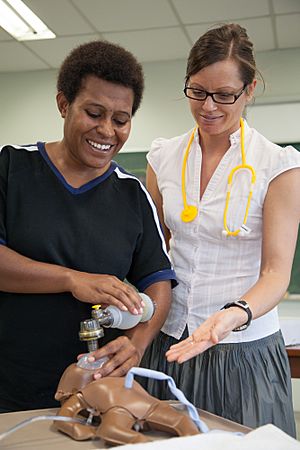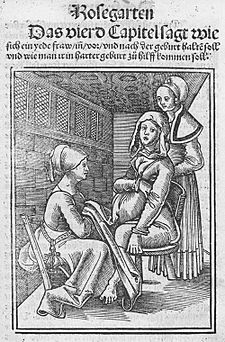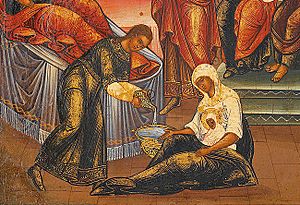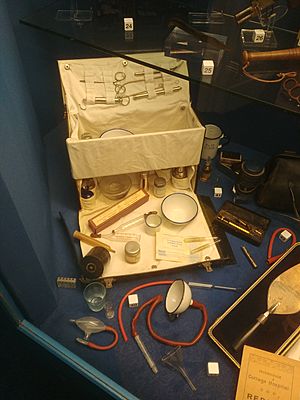Midwifery facts for kids
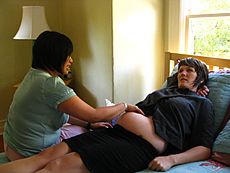
A pregnancy check-up by a midwife in a birth center
|
|
| Focus |
|
|---|---|
| Specialist | Midwife |
Midwifery is a special health profession that helps women during pregnancy, childbirth, and the time right after the baby is born. This includes caring for the newborn baby. Midwives also help women with their reproductive health throughout their lives. In many countries, being a midwife is a medical job that requires special training. A person who works in midwifery is called a midwife.
A study from 2013 found that most women should be offered care where one or more midwives are in charge. This type of care was linked to less use of epidurals (pain medicine during labor). It also meant fewer episiotomies (small cuts during birth) or births using special tools. There was also a lower risk of losing the baby before 24 weeks of pregnancy. However, this type of care was also linked to labor lasting a bit longer.
Contents
What Midwives Do
Midwives help women through all stages of having a baby. They also support women's health in general.
Pregnancy Care
Midwives provide care and support during pregnancy. This is also called Prenatal care.
First Trimester
A trimester means "three months." A normal pregnancy usually lasts about nine months. It is divided into three trimesters.
In the first three months, women usually have some tests. These often include urinalysis (a urine test) and blood tests. Blood tests check things like blood type, and for infections like hepatitis or HIV. They also check for rubella. Sometimes, women are tested for chlamydia or for conditions like sickle cell disease. Women must agree to all tests before they are done.
The midwife will also check the woman's blood pressure, height, and weight. They will talk about past pregnancies and the family's health history. An ultrasound scan might be done in the first trimester. This helps to find the estimated due date for the baby. Some women might have tests for genetic conditions like Down syndrome. The midwife will also talk about healthy eating, exercise, and common pregnancy issues like morning sickness.
Second Trimester
During the middle three months of pregnancy, the mother visits the midwife about once a month. Her partner or a friend can come with her. The midwife talks about common pregnancy issues. These can include feeling tired, heartburn, or back pain.
The midwife will keep checking blood pressure and weight. They will also measure the mother's belly to see if the baby is growing well. Other lab tests might be done if needed.
Third Trimester
In the last three months, the midwife sees the mother more often. They visit every two weeks until week 36, and then every week after that. Weight, blood pressure, and belly measurements continue. More lab tests might be done for some pregnancies.
The midwife will gently feel the woman's belly to check the baby's position. They might also do a pelvic exam to see if the mother's cervix is opening. The midwife and mother will talk about birth options. They will also make a plan for the birth.
Childbirth
Labor and Delivery
Midwives are trained to help with normal births. If a birth is more complicated, a doctor with extra training will step in.
After the Baby is Born
This time is called the Postpartum period.
After a hospital birth, mothers usually stay for at least six hours. They can choose to leave later if they wish. Midwives check on the mother and baby every day while they are in the hospital. They check the mother's health, her belly, and any stitches if she had a C-section. They also make sure she is recovering well.
The baby is also checked for things like jaundice (yellow skin) and feeding well. The baby has a full check-up between six and 72 hours after birth. This checks for heart problems, hip problems, or eye issues.
After leaving the hospital, a community midwife visits the woman at home. They visit until at least day ten. They do not visit daily but make sure the mother and baby are doing well. Around day five, the baby has a special screening test (heel prick test). The baby is weighed, and the midwife plans visits based on their health. After this, a health visitor takes over the care.
Care of the Newborn
When a baby is born, they get an Apgar score at one and five minutes of age. This score is out of 10. It checks five things: the baby's color, breathing, muscle tone, heart rate, and how they react to touch. Each area gets 0 to 2 points.
The midwife checks the baby for any obvious problems. They weigh the baby and measure their head size. The midwife makes sure the umbilical cord is clamped safely. They also put name tags on the baby if in a hospital. Midwives do these checks close to the mother. They return the baby to the mother quickly. Skin-to-skin contact is encouraged. This helps the baby's heart rate, breathing, and temperature stay steady. It also helps the mother and baby bond and helps with breastfeeding.
In some countries, like Chile, midwives can even lead special care units for newborns. This helps them use their knowledge to give high-quality care to babies with health problems.
Midwifery-Led Care
Midwifery-led care means that one or more midwives are mainly responsible for a woman's care during pregnancy and birth. They work with other health experts if needed. This is different from "medical-led care," where a doctor is mainly in charge. In some cases, care is "shared" between a midwife and a doctor.
Midwives are part of very personal moments with the mother. Because of this, many people say it's important to feel comfortable with your midwife. You will go to them with all your questions and concerns.
A study looked at public health systems in Australia, Canada, Ireland, New Zealand, and the UK. It found that most women should be offered midwifery-led care. Women should be encouraged to ask for this option. However, it might not be the best choice for women with serious medical issues.
Midwifery-led care has several good effects:
- Less use of epidurals, and fewer births needing cuts or special tools.
- Labor might be a bit longer.
- More chances of being cared for by a midwife the woman already knows.
- Lower risk of having the baby too early.
- Lower risk of losing the baby before 24 weeks of pregnancy.
There was no difference in the number of Caesarean sections (C-sections). The study only included licensed midwives, not traditional ones. It also did not include births outside of a hospital.
Women who had midwifery-led care were often more satisfied with their experience. This type of care can also save money compared to other types of care.
In midwifery-led care, the relationship between the midwife and the woman grows over time. This strong relationship is very important. It helps women feel understood, trusted, and in control of their birth experience.
In some cultures, midwifery is the most common way to have a baby. This tradition has been passed down for many generations. For example, in Zimbabwe, some women feel more comfortable with traditional care than in health facilities. The World Health Organization says women should be able to have their children where they feel safest. So, if having a midwife and giving birth at home makes a woman feel safe, then midwifery-led care might be the best choice for her.
History of Midwifery
Ancient Times
In ancient Egypt, midwifery was a known job for women. Old writings show that midwives helped with birth and cared for mothers and babies. They even had special birth chairs. Pictures on temple walls also show how important midwives were.
In ancient Greece and Rome, midwives were also common. Some were older women who used traditional methods. Others were trained and had a lot of knowledge. Some were even highly trained and seen as doctors. A doctor named Soranus of Ephesus wrote in the 2nd century about what a good midwife should be like. He said she should be smart, have a good memory, and love her work. She should also be kind and have soft hands.
Midwives had different names in ancient times, like maia (midwife) or obstetrix (birth helper). In the eastern part of the Mediterranean, some women became very skilled. They could even write books about women's health. This shows that midwifery was a respected job there. Some Roman laws also suggest that midwives were paid well, similar to male doctors.
However, in the Roman West, many midwives were formerly enslaved women who had gained their freedom. This suggests that the job was valued enough for them to earn money and become free. It is thought that mothers might have taught their daughters how to be midwives.
The main job of a midwife in ancient times was to help with birth. They might also help with other women's health issues. If a birth was difficult, the midwife would call for a doctor. Midwives often brought assistants with them. They believed that sitting upright made birth easier. So, they used a special birth stool with a hole for the baby to come through. The midwife would sit facing the mother, helping her and giving instructions.
After the baby was born, the midwife would receive the infant. They would cut the umbilical cord and clean the baby. They would also check the baby for any problems and listen to its cry. Midwives would decide if a baby was healthy enough to survive.
Midwife services were not cheap. This means poorer women often had to rely on female relatives for help. Wealthier families sometimes had their own midwives. Most women likely hired midwives, who could be highly trained or have basic knowledge. The quality of care often depended on how much money a family had.
Modern History

From the 1700s, doctors started to say that their new scientific methods were better than what midwives did. Doctors and medical groups tried to make it illegal for midwives to practice or to control them very strictly. This happened in the United States and Canada.
However, in Northern Europe and Russia, it was a bit easier for midwives. For example, a midwifery school for women was started in Russia in 1811. Even though some said midwives were "unskilled," others argued that poorly trained doctors were more dangerous. In 1846, a doctor named Ignaz Semmelweiss noticed that more women died in hospitals where male doctors worked than where midwives worked. He found that the doctors were not washing their hands after touching dead bodies. But his ideas about washing hands were ignored for a long time. They were only accepted when the idea of germs became widely known.
The argument that doctors were more dangerous than midwives continued until the early 1900s. At that time, the study of bacteria became popular, and hospitals became much cleaner. Women then started to feel safer giving birth in hospitals.
Today
By the late 1900s, midwives were seen as highly trained professionals in birth care. But even today, in Western countries, pregnancy and childbirth are often seen as possibly risky. Midwives who work in hospitals are sometimes influenced by this view. However, they are mostly trained to see birth as a normal and healthy process.
Midwives play a much bigger role in caring for pregnant mothers in Europe than in America. Still, the idea of birth as a medical event has an impact there too. This is even though the World Health Organization suggests a natural and humanized birth.
In Sweden and the Netherlands, the midwifery model of care is very strong. Swedish midwives provide 80% of prenatal care and most family planning services. They attend almost all normal births in public hospitals. Swedish women often have fewer medical procedures during birth than American women. The Netherlands has one of the lowest infant death rates in the world. Midwives in the Netherlands and Sweden have been very successful because their governments support them.
See also
 In Spanish: Obstetricia (matronería) para niños
In Spanish: Obstetricia (matronería) para niños
- Afghanistan Midwifery Project
- Childbirth and obstetrics in antiquity
- Global Library of Women's Medicine
- International Confederation of Midwives
- Obstetrics
- Midwifery in Maya society


